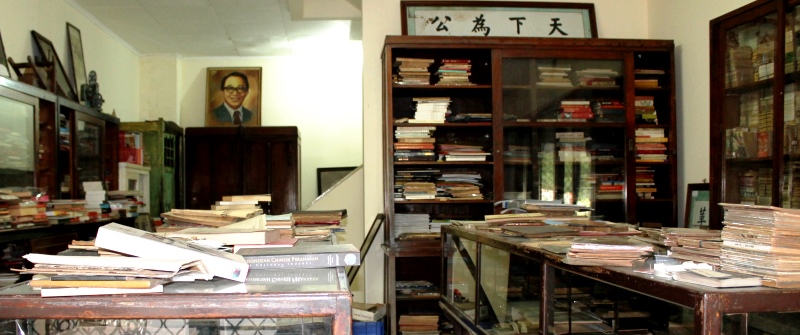
11 Aug Blog: Books written for everyone (and protected by a few)
By Tom Hoogervorst
Indonesia’s Chinese authored literature reached its peak of popularity in the 1930s. Access to these unique sources is slowly improving. Tom Hoogervorst escaped Jakarta’s archives for a rendezvous with two passionate guardians of the ‘Sino-Malay’ literary heritage.
From colonial times onwards Indonesia’s mixed Chinese population (Peranakan) used the Malay language to satisfy their literary ambitions. The numerous novels, periodicals and newspapers they produced add an important, non-Eurocentric dimension to the study of Indonesia’s past.
Fast forward to 2016, and I weave through Jakarta’s traffic astride a shamrock-hued Go-Jek. First stop – Bintaro, where I am meeting Myra Sidharta at her house. A psychologist by training and fluent in half a dozen languages, this 1927-born icon of the Chinese-Indonesian community is also an expert and aficionada of Sino-Malay literature. She particularly enjoys the beautiful language of the authors Njoo Cheong Seng and Tan Hong Boen, better known under their pen names Monsieur d’Amour and Ki Hadjar Dharmopralojo respectively. But reading, researching and collecting Sino-Malay literature is not enough for Myra. She has spent decades making her large personal collection publicly available, and continues to do so up to this day. In fact, Leiden’s online Sino-Malay collection would have been substantially less impressive if not for the hundreds of microfilms supplied by Myra in the 1980s.
Still reeling from Myra’s vivid first-hand accounts of Chinese-Indonesian cultural history – not to mention an equally invigorating lunch – I continue my one-day quest to Serpong. I am meeting Azmi Abubakar, head of Indonesia’s very first Peranakan Chinese Book Museum (Museum Pustaka Peranakan Tionghoa). Dwarfed by the nearby ITC BSD shopping centre, this landmark of Indonesia’s literary heritage sits somewhat inconspicuously between the Golden Road shophouses.
A bookseller of Acehnese origins, Azmi grew up in a completely different milieu from the Peranakan Chinese. Yet as he began to delve deeper into his own heritage he became aware of the intimate historical connections between China, its overseas diasporas and the Indonesian archipelago. At that point he decided to stop selling Sino-Malay books and newspapers. His antiquarian bookshop became a museum open for academics, students and other book lovers.
“Earlier this year, a student booked a hotel around the corner and spent two weeks at this museum”, tells Azmi. “She was interested in different versions of Sam Kok – the famous Chinese novel also known as Romance of the Three Kingdoms – and no library in the world was able to help her. Did you know that the Malay translation of Sam Kok came out earlier than the English one? If more Indonesians would understand that this is also their heritage, and that the Chinese-Indonesians aren’t malignant outsiders but important contributors to the history of the archipelago, that would be the end of anti-Chinese violence – like last month in Tanjung Balai.”
In the past Azmi has had to mobilise his friends – all veterans from Indonesia’s 1998 pro-democracy movement – to protect his unique collection against local thugs who accused the museum of pro-China sympathies. In reality, this literary heritage very clearly transgresses the boundaries of nation, gender and religion. Many colonial-era authors insisted that their work was to be enjoyed by segala bangsa, all ethnicities, and I am not alone in hoping that this will soon be the case once more.
(Tom Hoogervorst focuses on language contact and Malay linguistics. He is currently studying the development of the (Indonesian) Malay language through the KITLV’s collection of Sino-Malay literature, while simultaneously attempting to cast a new light on cultural contact, the introduction of new concepts and the role of popular culture during late 19th and early 20th centuries.)




Christopher Allen Woodrich
Posted at 14:46h, 11 AugustBrilliant look at the need to protect these collections. I have a few dozen pieces of Chinese-Malay literature myself, and every time I read one I see just how much Indonesian culture and language is reflected in these works. The idiom “Daun muda” (young girl), for example, is used in Tio Ie Soei’s Pieter Elberveld in the form “kambing tua makan daun muda” (the old goat [i.e. old man] eats the young leaves.
I hope KITLV and other institutions have digitized or are considering digitizing their collections and making them available publicly. They offer such interesting alternatives to the government-backed canon of Indonesian literature.
Martin van Bruinessen
Posted at 19:02h, 11 AugustI think you should have mentioned the important work done on this literature by Claudine Salmon, who published a major overview 35 years ago. At the time, that was a revolutionary revision of the history of Indonesian literature (as for instance in Hans Teeuw’s celebrated work, which completely neglected the Chinese contribution).
Claudine Salmon, Literature in Malay by the Chinese of Indonesia : a provisional annotated bibliography, Paris: Éditions de la Maison des Sciences de l’Homme, 1981.
Tom Hoogervorst
Posted at 17:15h, 22 SeptemberThanks for the comments. Christopher, plans to digitize the KITLV collection are ongoing. Martin, I do indeed draw thankfully from Claudine Salmon’s great overview and many other publications, which is why I hyperlinked it (fifth line; the word “novels”).
Melita Tarisa
Posted at 21:46h, 07 December“If more Indonesians would understand that this is also their heritage, and that the Chinese-Indonesians aren’t malignant outsiders but important contributors to the history of the archipelago, that would be the end of anti-Chinese violence – like last month in Tanjung Balai.”
This is a very strong remark!
I recently stumbled upon the KITLV collection of the Sino-Mlaay literature and, being a Chinese-Indonesian myself, that was the sentiment which came across my mind. I never knew that Chinese-Indonesian has such a lively literary tradition. I will visit the museum during my holiday!
I hope to learn more from your research!